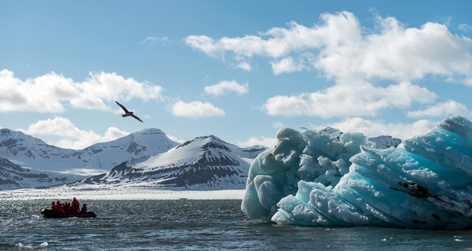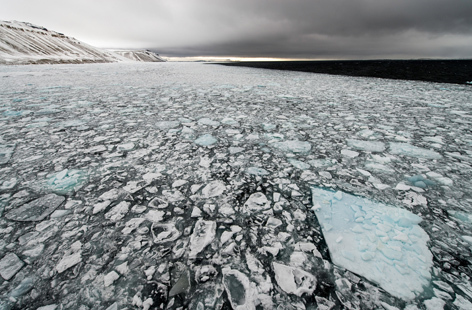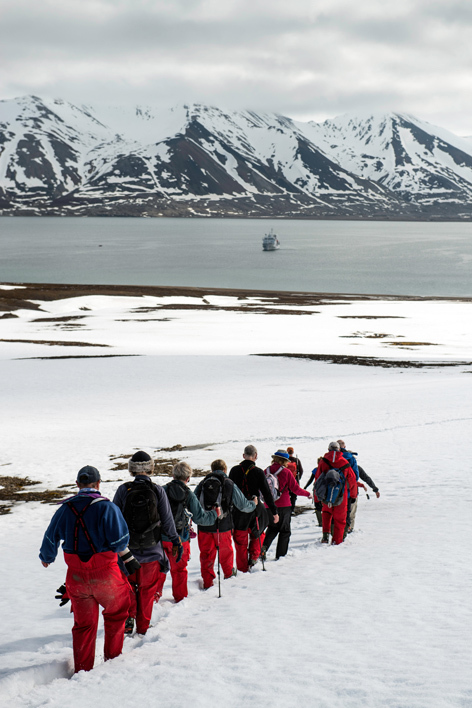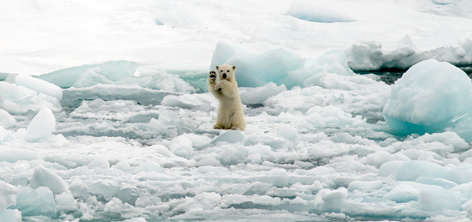Polar bears could become a nostalgic memory within our lifetime. We visit Svalbard, a habitat at risk, and find out why this pristine place is worth protecting
“When you get back home, friends will probably struggle to understand what you’ve been through.”
It’s quite some introduction to a two-week holiday but I know our tour leader, Paul Goldstein, is right. Svalbard, a mountainous archipelago in the High Arctic, has that effect on people. I’ve been fortunate enough to visit on several occasions, and the beauty of its unpredictable and unknown landscapes only intensifies each time.
It’s a pristine, precious place, and anyone who comes here will leave wanting to protect it, in the same way a mother has an instinctive urge to coddle a vulnerable child.
 Scenes switch from the Arctic desert of Torellneset, where thigmotactic walruses snuggle together on shingle beaches and diminutive purple saxifrage grow in ancient whale graves, to the brilliant 30m ice cliffs of Brasvellbreen, calving to form a sea of Slush Puppy. And most dramatic, vital and fragile of all – the sea ice, a lifeline for many of the species who manage to survive here.
Scenes switch from the Arctic desert of Torellneset, where thigmotactic walruses snuggle together on shingle beaches and diminutive purple saxifrage grow in ancient whale graves, to the brilliant 30m ice cliffs of Brasvellbreen, calving to form a sea of Slush Puppy. And most dramatic, vital and fragile of all – the sea ice, a lifeline for many of the species who manage to survive here.
And it’s ice that we’re searching for as we steady ourselves on the stern of Russian research vessel, the Vavilov, accompanied by stiff-gliding fulmars catching a ride on rising air currents.
But it’s not an easy task. This year, ice cover in the Arctic fell to its fifth lowest level on record. Most affected by this alarming development are polar bears, marine mammals that rely on floating hunting platforms to catch seals, their main prey.
By the time we arrive, many have already been forced north and east, away from the bio-productive continental shelf where they should be congregating at this time of year.
But of all the ships currently navigating Svalbard, we have the best chance of striking lucky with bears.
 Wildlife photographer Paul has chartered the Vavilov and its esteemed One Ocean crew, and is joined by Last Chance To See TV personality and conservationist Mark Carwardine. Together, they bring knowledge, expertise, good – and often bad – humour to the table, and an unfaltering dedication to deliver.
Wildlife photographer Paul has chartered the Vavilov and its esteemed One Ocean crew, and is joined by Last Chance To See TV personality and conservationist Mark Carwardine. Together, they bring knowledge, expertise, good – and often bad – humour to the table, and an unfaltering dedication to deliver.
Easing into our new environment, we take a Zodiac cruise to Brepollen, a large glacial deposit at the head of a fjord in Hornsund. Above us, lenticular clouds are forming, like eddies whirling in the cool katabatic winds sweeping off the glaciers.
With all the grace of winged celestials, ivory gulls settle on electric blue icebergs, as shards of 1,000-year-old ice groan, creak and calve into the water.
“In the last 11 years, I’ve seen some glaciers retreat up to two nautical miles,” says our expedition leader John Rodsted, as we coast through the bay. I ask if he believes climate change is to blame. He stops the propeller, narrows his gaze and replies: “It’s not a belief, it’s a fact.”
It’s an opinion shared by other specialists on board, including respected marine mammal expert Dr Ian Stirling, a friend of Paul’s who’s joined us on the voyage. There are an estimated 20,000-25,000 polar bears worldwide, but if climate change continues at the current rate, there’s a risk we could lose 66% of that population within the next 40 years.
 So when we do finally spot a bear, we’re relieved, most of all, to discover he looks healthy. With 24-hour daylight, sightings can happen at any time, and as we approach 80 degrees north in the early hours, an alert goes out over the ship’s tannoy, with Paul screaming at anyone who’s dared to waste five minutes by changing out of their pyjamas.
So when we do finally spot a bear, we’re relieved, most of all, to discover he looks healthy. With 24-hour daylight, sightings can happen at any time, and as we approach 80 degrees north in the early hours, an alert goes out over the ship’s tannoy, with Paul screaming at anyone who’s dared to waste five minutes by changing out of their pyjamas.
The reward, though, is worth it. A divan of fresh snow softens the blow of a bruised, aubergine sky, and behind a frozen cushion rests a buttery yellow blob. As we slowly approach, drifting through a mosaic of splintered ice, he raises a padded nose to the air and acknowledges our arrival. And as due payment for our patience, he rolls on his back, flicks legs in the air in a series of yogic poses, then shows off his strength and agility by propelling 500kg of body mass between wafer-thin ice floats.
As if by domino effect, a succession of Ursus maritimus then follows. From bears stretching, sniffing, swimming and sleeping, we tot up a remarkable total of 13 over the next few days. One woman, so weary from the bears’ unsociable hours, is even heard mumbling in the stairwell: “I hope the next one can wait until after breakfast.”
But it’s quality, not quantity, that matters, and our most emotional and memorable sighting takes place at Wahlenbergfjorden on Nordaustlandet. It’s spotter Mette’s birthday, and nature’s gift to her is a mother with three seven-month cubs. Spellbound, we spend two hours with them, although time races away in what feels like 20 minutes.
While their mother searches for food, the young cubs play – embracing each other, as if dancing in a circle, stuffing ice in their mouths, and even raising one paw, seemingly giving us a high five. Ian, like the rest of us, is speechless; he hasn’t seen anything like this in the last decade.
Our exuberance, though, is tainted only by the sober fact that these are probably the only cubs the Vavilov will encounter this year. According to scientific research by the Norwegian Polar Institute, who assessed the behaviour of 29 tagged bears in Svalbard, the number of females giving birth has crashed from 30% to 10% within 12 months.
 Svalbard’s story, though, is far from being one of sadness. The Arctic is full of life, a fact confirmed on a trip to Diskobukta, a bay on the island of Edgeoya. With landings only possible before or after high tide, few people are able to visit, but the One Ocean crew rises to the occasion yet again.
Svalbard’s story, though, is far from being one of sadness. The Arctic is full of life, a fact confirmed on a trip to Diskobukta, a bay on the island of Edgeoya. With landings only possible before or after high tide, few people are able to visit, but the One Ocean crew rises to the occasion yet again.
The headliner here is a narrow canyon, where thousands of black-legged kittiwakes nest. Quarrelsome residents of an overcrowded high rise, they squawk and squabble for territory, with the less fortunate sent cartwheeling off ledges and into the jaws of Arctic foxes waiting eagerly below. We stand amid the chaos, as a shower of fluttering white ticker tape litters the blue sky.
The most positive event of all, though, is our sighting of a blue whale; an animal thought to have vanished from these waters after being hunted for centuries. Having identified several blows on the horizon, Mark, also a cetacean expert, invites us on deck, but no one is prepared for the epic emergence of an 18m juvenile alongside the bow. For the next 45 minutes, 70 guests fall silent, as we unanimously draw breath trying to anticipate where he might next surface.
Occupying the second rung in the food chain, whales will be crowned apex predators of the Arctic should bears die out. Perhaps, then, the plight of the polar bear is merely evolution; after all, thousands of species disappear each year, some of which will be forever undiscovered.
Yet it’s a thought I’d rather not entertain. Standing alone at the stern of the ship, I watch the last pieces of ice drift into the horizon, becoming infinitely smaller until only calm, uneventful sea remains.
How all too easy it is, I remark to myself, for a world to melt away.
THE HOLIDAY
Sarah Marshall was a guest of Paul Goldstein and Exodus Travels. In 2015, Paul Goldstein and Mark Carwardine will be running two 12-night trips to Svalbard on June 21 and July 2, with prices starting from £3,899 per person, excluding flights.
